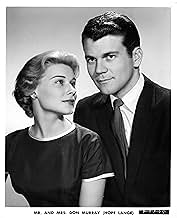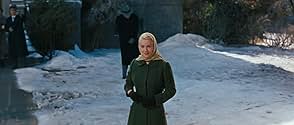Hope Lange(1933-2003)
- Actress
- Soundtrack
One of the most natural beauties of the 1960s with a gentle voice and
personality to match, blonde Hope Lange was born in Redding Ridge,
Connecticut, and performed on stage from the age of nine. She studied
both drama and dance under Martha Graham,
did some modeling and then worked in stock companies and on television,
dancing on Jackie Gleason shows.
She acted in just a handful of motion pictures, garnering an Academy
Award nomination for one, and later won two Emmys for her best-loved
role on television.
Hope was one of four children of an actress mother, upon whose shoulders fell the responsibility of supporting the family after the premature death of her father, the composer/arranger John Lange, at age 61 in 1942. Along with her siblings, she worked as a waitress in the family's Greenwich Village restaurant, 'Minette's of Washington Square'. By chance, she made the acquaintance of Eleanor Roosevelt, who owned an apartment in the village, and ended up walking the former First Lady's prized Scotch terrier, Fala. This got her photo into a newspaper, which, in turn, led to an advertising job with pictures on the June 1949 cover of 'Radio-Electronics', sporting the futuristic red 'Man from Mars' pith helmet with built-in radio. Still just fifteen years old, Hope spent the next two years at college in Oregon and New York, then found her first job in television and was subsequently signed by 20th Century-Fox.
After successful screen tests, Lange made her motion picture debut in Bus Stop (1956) (Barbara Eden was one of her competitors for the part) opposite Marilyn Monroe and husband-to-be Don Murray. Even the great Marilyn was said to have felt a little threatened by another blonde who was not only beautiful but five years younger and could act as well. After playing the wife of the titular character in The True Story of Jesse James (1957), a picture which she later referred to as a 'turkey', Lange was cast as the fragile Selena Cross in the melodramatic but good-looking soap opera Peyton Place (1957). This movie was regarded as risqué and controversial at the time, dealing with previously taboo subjects such as rape and incest. For her part of the abused girl, raped by her alcoholic stepfather, whom she finally kills in self-defense, Lange received an Academy Award nomination.
The glossy production values of The Best of Everything (1959), a film about ambitious New York career women working in a magazine publishing house, overshadowed most of the character development. However, Lange (who was billed above the established star Joan Crawford) was dealt with most favorably by the critics. According to Bosley Crowther of The New York Times: "Simply because she has the most to do, and does it gracefully, Miss Lange comes off best' (October 9,1959). The following decade was to be a period of mixed fortunes for Hope Lange.
In 1961, Lange began a long-standing relationship with fellow actor Glenn Ford and left husband Don Murray. Ford, in his dual role of star and associate producer, put pressure on director Frank Capra to cast Lange as the female lead in his next motion picture, the whimsical Damon Runyon-inspired comedy Pocketful of Miracles (1961), even though Shirley Jones had already been assigned to the role. Capra reluctantly gave way, though Hope Lange was likely miscast as the wisecracking showgirl. Lange again co-starred with Ford in the glossy romantic melodrama All This and Money Too (1963), wherein acting took a back seat to sumptuous costumes and the French Riviera. On the negative side of the ledger, Lange had unsuccessfully auditioned for the part of Maria in West Side Story (1961), which ultimately went to Natalie Wood. Instead, she was cast as Elvis Presley's psychiatrist in Wild in the Country (1961), which was generally panned by critics, except for Variety singling out her performance above the rest as 'intelligent' and 'sensitive'. Lange was also slated to appear as love interest to George Peppard in How the West Was Won (1962), but her scenes ended up on the cutting room floor.
Turning increasingly towards television, Hope Lange achieved her most lasting fame as the popular star of the amiable sitcom The Ghost & Mrs. Muir (1968) as a widow who (with two kids and a housekeeper) takes up residence in a quaint cottage also inhabited by the cantankerous ghost of a sea captain (Edward Mulhare). The show ran for three seasons and Lange won two Emmy Awards for Outstanding Continued Performance by an Actress in a Leading Role in a Comedy Series (1969 and 1970). In her only other recurring TV role, she played Dick Van Dyke's wife in The New Dick Van Dyke Show (1971), but with less rewarding results. She received good notices for portraying Charles Bronson's dying wife, the victim of the original Death Wish (1974) and its raison d'etre. She then acted primarily on television, with few exceptions, including Blue Velvet (1986) and Clear and Present Danger (1994) as a U.S. senator. In 1977, she replaced Tony Award-winning Ellen Burstyn in the starring role of Doris in 'Same Time, Next Year' on Broadway.
In the early '90s, Lange underwent surgery for a brain tumour. While the operation was successful, her health remained precarious and she limited her screen appearances, retiring altogether in 1998. She died of an intestinal infection in December 2003, aged 70.
Hope was one of four children of an actress mother, upon whose shoulders fell the responsibility of supporting the family after the premature death of her father, the composer/arranger John Lange, at age 61 in 1942. Along with her siblings, she worked as a waitress in the family's Greenwich Village restaurant, 'Minette's of Washington Square'. By chance, she made the acquaintance of Eleanor Roosevelt, who owned an apartment in the village, and ended up walking the former First Lady's prized Scotch terrier, Fala. This got her photo into a newspaper, which, in turn, led to an advertising job with pictures on the June 1949 cover of 'Radio-Electronics', sporting the futuristic red 'Man from Mars' pith helmet with built-in radio. Still just fifteen years old, Hope spent the next two years at college in Oregon and New York, then found her first job in television and was subsequently signed by 20th Century-Fox.
After successful screen tests, Lange made her motion picture debut in Bus Stop (1956) (Barbara Eden was one of her competitors for the part) opposite Marilyn Monroe and husband-to-be Don Murray. Even the great Marilyn was said to have felt a little threatened by another blonde who was not only beautiful but five years younger and could act as well. After playing the wife of the titular character in The True Story of Jesse James (1957), a picture which she later referred to as a 'turkey', Lange was cast as the fragile Selena Cross in the melodramatic but good-looking soap opera Peyton Place (1957). This movie was regarded as risqué and controversial at the time, dealing with previously taboo subjects such as rape and incest. For her part of the abused girl, raped by her alcoholic stepfather, whom she finally kills in self-defense, Lange received an Academy Award nomination.
The glossy production values of The Best of Everything (1959), a film about ambitious New York career women working in a magazine publishing house, overshadowed most of the character development. However, Lange (who was billed above the established star Joan Crawford) was dealt with most favorably by the critics. According to Bosley Crowther of The New York Times: "Simply because she has the most to do, and does it gracefully, Miss Lange comes off best' (October 9,1959). The following decade was to be a period of mixed fortunes for Hope Lange.
In 1961, Lange began a long-standing relationship with fellow actor Glenn Ford and left husband Don Murray. Ford, in his dual role of star and associate producer, put pressure on director Frank Capra to cast Lange as the female lead in his next motion picture, the whimsical Damon Runyon-inspired comedy Pocketful of Miracles (1961), even though Shirley Jones had already been assigned to the role. Capra reluctantly gave way, though Hope Lange was likely miscast as the wisecracking showgirl. Lange again co-starred with Ford in the glossy romantic melodrama All This and Money Too (1963), wherein acting took a back seat to sumptuous costumes and the French Riviera. On the negative side of the ledger, Lange had unsuccessfully auditioned for the part of Maria in West Side Story (1961), which ultimately went to Natalie Wood. Instead, she was cast as Elvis Presley's psychiatrist in Wild in the Country (1961), which was generally panned by critics, except for Variety singling out her performance above the rest as 'intelligent' and 'sensitive'. Lange was also slated to appear as love interest to George Peppard in How the West Was Won (1962), but her scenes ended up on the cutting room floor.
Turning increasingly towards television, Hope Lange achieved her most lasting fame as the popular star of the amiable sitcom The Ghost & Mrs. Muir (1968) as a widow who (with two kids and a housekeeper) takes up residence in a quaint cottage also inhabited by the cantankerous ghost of a sea captain (Edward Mulhare). The show ran for three seasons and Lange won two Emmy Awards for Outstanding Continued Performance by an Actress in a Leading Role in a Comedy Series (1969 and 1970). In her only other recurring TV role, she played Dick Van Dyke's wife in The New Dick Van Dyke Show (1971), but with less rewarding results. She received good notices for portraying Charles Bronson's dying wife, the victim of the original Death Wish (1974) and its raison d'etre. She then acted primarily on television, with few exceptions, including Blue Velvet (1986) and Clear and Present Danger (1994) as a U.S. senator. In 1977, she replaced Tony Award-winning Ellen Burstyn in the starring role of Doris in 'Same Time, Next Year' on Broadway.
In the early '90s, Lange underwent surgery for a brain tumour. While the operation was successful, her health remained precarious and she limited her screen appearances, retiring altogether in 1998. She died of an intestinal infection in December 2003, aged 70.





























